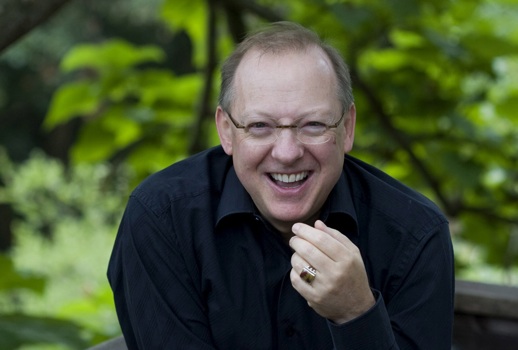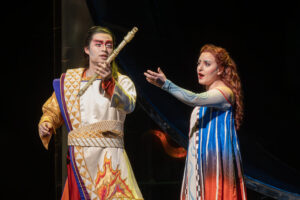

Now in its 29th season under founder Thomas Crawford and originally known as the Orchestra of the Old Fairfield Academy, this period-instrument group shifted from its usual classical focus to the baroque by bringing in to conduct Samson noted Handelian Nicholas McGegan who led with a propulsive momentum and drew fiercely committed playing from his eager orchestra (despite a pair of recalcitrant horns that never did find focus). In the past I have sometimes found McGegan’s Handel over-fussy and undramatic (particularly on recordings), but this was not at all the case during Tuesday’s necessarily abridged reading; Samson is a long work whose uncut score lasts nearly three-and-a-half hours—McGegan’s version ran just under three hours, including an intermission after Act I and a pause following Act II.
Written just after Messiah and premiering at Covent Garden in 1743, Samson draws upon both Biblical sources and John Milton’s drama Samson Agonistes and differs substantially from Saint-Saëns’s more familiar opera treatment. Dalila, here Samson’s wife, has already betrayed the Israelite hero who is being held blind and defeated by the Philistines, comforted by his loyal friend Micah and his father Manoa. Dalila and the warrior Herapha visit to taunt the vanquished hero who eventually regains his strength and accepting Herapha’s challenge destroys (off-stage) the temple along with himself. The oratorio concludes with mourning for the fallen Samson.
The premiere proved an important success and the work was done many times during the composer’s lifetime including a memorable later performance when the now-blind composer was noted to be visibly moved at Samson’s shattering aria “Total eclipse! No sun, no moon,/All dark amidst the blaze of noon!” Despite that early success and its many memorable pages, Samson has always seemed to me one of Handel’s weakest oratorios, its libretto by Newburgh Hamilton lacking the multi-faceted characters and engrossing drama of the composer’s best.
Samson is a mostly static protagonist to whom little happens in the long first act. The second is enlivened by those encounters with Herapha and particularly Dalila whose haughty colloquy with her estranged husband proves to be the oratorio’s high point. Throughout the work a number arias are assigned to anonymous characters—the Philistine Man and Woman and the Israelite Man and Woman—further diluting the drama. The final act features Samson’s ravishing farewell “Thus when the sun from’s wat’ry bed”
…and then portends Samson’s impeding death.
Except for those second act confrontations, there’s otherwise not much drama which is atypical for a Handel oratorio—towering works like Saul (one of the greatest of all 18th century music dramas), Jephtha, Belshazzar and the “secular” pair of Semele and Hercules all crackle with the conflicts of its characters in extremis.
Whenever I want to listen to an oratorio, I rarely pull Samson off the shelf—I even prefer such disdained works as Joseph and his Brethren or Alexander Balus (another fascinating Handel portrait of Cleopatra). However, the work is clearly a favorite of McGegan who recently recorded it live at Dresden’s restored Frauenkirche with the forces of the Göttingen Handel Festival where he was the music director for many years and starring Tuesday’s tenor Thomas Cooley in the title role, but, as impressive as Tuesday’s performance was, I remain mostly unpersuaded by Samson.
And yet the 24-member American Classical Orchestra Chorus gave enormous pleasure in the many choruses—sometimes of Israelites, sometimes of Philistines—that dot the work. I shake my head when I read about oratorio performance featuring over-sized choruses since Handel’s choral writing thrives on the precision and clarity possible with a fine small chorus, and it’s astounding what a thrilling, hall-filling noise just 24 voices can make.
Basses John Taylor Ward and Andrew Padgett gave solid accounts of Manoa and Herapha respectively. Both, however, displayed light, baritonal voices that coped well with the florid writing but they unfortunately failed to bring the proper gravitas to Samson’s mourning father particularly in his piercingly beautiful farewell to his son “How willing my paternal love” or the fatuous braggadocio to the Philistine blowhard in his “Honour and arms scorn such a foe.”
Mezzo Virginia Warnken gave a warmly comforting portrayal of the occasionally dreary Micah which proved to more of a contralto role occasionally causing strain at the bottom of her voice. Happily her strongest work was the Micah’s best piece, “Return, O God of Hosts!” Surely the only role recorded by both Janet Baker and Martina Arroyo, Dalila, sung here by Megan Chartrand strikingly enveloped in a bright red gown, began with a jauntily insinuating “With plaintive notes” conducted faster than usual and unfortunately shorn of its da capo.
Her bright, agile voice evoked a younger, more playful Dalila than usual. She was joined in a ravishing rendition of the duet “My faith and truth” by the excellent Sarah Brailey, who had made a similarly fine impression at my previous encounter with ACO—a performance of Mendelssohn’s complete incidental music for A Midsummer Night’s Dream.
During Act III apparently Chartrand had a change of heart and converted to Judaism to become the Israelite Woman who closes the work with the famous “Let the bright seraphim” of which she rightly sang only the A and B sections leading into the final chorus “Let their celestial concerts all unite.” I have to admit though that I miss the aria’s da capo as that version was the first music I ever heard from Samson—on Joan Sutherland’s epochal Art of Prima Donna. Although that studio recording is pretty thrilling, my favorite Sutherland version comes from a 1960 performance of Handel’s Alcina in Venice where after the opera she gives an encore(!): “Let the Bright Seraphim”–in Italian!
Samson, written for one of Handel’s favorite singers, John Beard, was one of first leading roles ever written for a tenor: heroes in opera seria always had high (castrato) voices. For many recent listeners, Samson is Jon Vickers, the Canadian dramatic tenor who first sang the role in the same 1959 Covent Garden production that introduced Sutherland’s Israelite Woman.
Hearing that suave performance may prove a revelation if you’re only familiar with the Samsons Vickers sang in stage productions toward the end of his career, including one at the Met in 1986. By then, his interpretation had acquired a self-absorbed grandiosity that more often than not left poor Handel behind.
Unlike Vickers or Samsons like Jan Peerce or Richard Tucker, American tenor Cooley instead brought a more pleasing baroque sensibility to his portrayal at Tully. Possessing a dark earthy voice with exemplary diction and splendid coloratura, he would seem to have all the right ingredients for an ideal Samson. However, it didn’t consistently come together on Tuesday, as he alternated nuanced singing with occasional hectoring which pushed him loudly off pitch. The finest moment of his tortured portrayal was that moving final aria “Thus when the sun from’s wat’ry bed.”
I’m hopeful that Tuesday’s audience’s enthusiastic response might lead the orchestra to program more of these unfairly neglected works, perhaps inviting McGegan back for, say, Susanna?
Photo of Nicholas McGegan by Sandy Beach.

























Comments